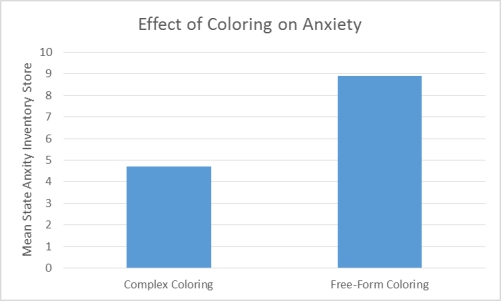Multiple Choice
Use the following to answer questions
Scenario I
Scenario I is based on fabricated data inspired by the following study:
Curry, N. A. & Kasser, T. (2005) . Can coloring mandalas reduce anxiety? Art Therapy: Journal of American Art Therapy Association, 22(2) 81-85.
Effect of Coloring on Anxiety
Curry and Kasser were interested in examining whether coloring complex geometric patterns reduces anxiety. To that end, they induced anxiety in 84 undergraduate volunteers from their university. Following anxiety induction the participants were divided into two coloring conditions. To determine which condition each participant would be in the researchers put all of their names in a hat. The first name drawn was placed in group 1, the second name drawn was placed in group 2, the third name drawn was placed in group 1, and so on. Those in the complex geometric coloring condition (group 1) were given a paper with a plaid pattern or the outline of a mandala. Those in the control condition (group 2) were given a blank piece of paper. After 20 minutes of coloring all of the participants completed a self-administered State Anxiety Inventory (SAI) . Lower SAI scores indicate low levels of anxiety whereas higher SAI scores indicate high levels of anxiety. The mean SAI scores of each coloring condition were compared to determine whether the type of coloring one does affects anxiety. The results revealed that those who colored a complex geometric pattern had significantly different levels of anxiety than those who colored on a blank sheet of paper. Curry and Kasser concluded that coloring causes a change in anxiety, but only when coloring requires a certain amount of attention and focus.
Figure 1. Effect of Coloring on Anxiety

-(Scenario I) Let's say you are skeptical of the results of this study. You set out to replicate it to determine for yourself whether coloring affects anxiety. Since you don't have access to the State Anxiety Inventory you decide to measure participants' heart rate instead. In doing this, you have changed:
A) the research design.
B) the levels of your independent variable.
C) the operational definition of your dependent variable.
D) the way in which you will analyze the results.
Correct Answer:

Verified
Correct Answer:
Verified
Q12: (Scenario II) Which of the following is
Q26: Although Armand has not conducted any formal
Q27: In an experiment designed to examine the
Q29: Select the factor that is NOT unique
Q34: How can a researcher increase the internal
Q35: As the number of participants in an
Q36: Imagine that you were recently in an
Q93: A self-report measure may be inappropriate when
Q96: For which of the following would a
Q121: Which of the following represents the largest